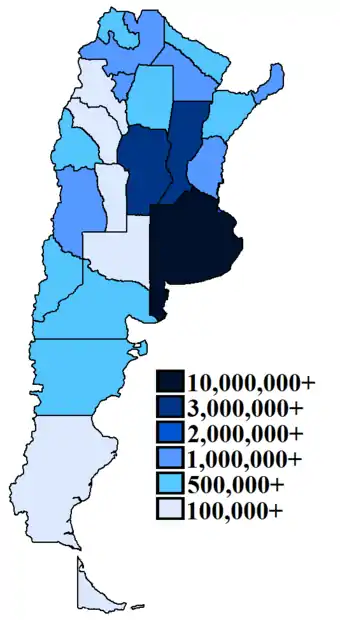List of Argentine provinces by population
The following table is a list of the 23 provinces and the Autonomous City of Buenos Aires of Argentina, ranked in order of their total population based on data from 2013 estimates, 2010 and 2001 census from the National Institute of Statistics and Census of Argentina.[1]
| Rank | Province/District | Population (2013)[2] | Population (2010)[3] | Population (2001)[4] |
|---|---|---|---|---|
| 1 | 16,289,599 | 15,625,084 | 13,827,203 | |
| 2 | 3,489,669 | 3,308,876 | 3,066,801 | |
| 3 | 3,341,228 | 3,194,537 | 3,000,701 | |
| 4 | 3,044,076 | 2,890,151 | 2,776,138 | |
| 5 | 1,841,813 | 1,738,929 | 1,579,651 | |
| 6 | 1,551,460 | 1,448,188 | 1,338,523 | |
| 7 | 1,295,944 | 1,214,441 | 1,079,051 | |
| 8 | 1,295,121 | 1,235,994 | 1,158,147 | |
| 9 | 1,159,445 | 1,101,593 | 965,522 | |
| 10 | 1,117,953 | 1,055,259 | 984,446 | |
| 11 | 1,049,325 | 992,595 | 930,991 | |
| 12 | 908,268 | 874,006 | 804,457 | |
| 13 | 721,830 | 681,055 | 620,023 | |
| 14 | 710,121 | 673,307 | 611,888 | |
| 15 | 678,797 | 638,645 | 552,822 | |
| 16 | 601,003 | 551,266 | 474,155 | |
| 17 | 568,331 | 530,162 | 486,559 | |
| 18 | 545,656 | 509,108 | 413,237 | |
| 19 | 463,411 | 432,310 | 367,933 | |
| 20 | 389,256 | 367,828 | 334,568 | |
| 21 | 357,516 | 333,642 | 289,983 | |
| 22 | 336,706 | 318,951 | 299,294 | |
| 23 | 302,420 | 273,964 | 196,958 | |
| 24 | 143,987 | 127,205 | 101,079 |

Map of each province's population as of 2010
References
- (in Spanish) Censo 2010: Censo Nacional de Población, Hogares y Viviendas Archived 2011-06-15 at the Wayback Machine
- "Archived copy". Archived from the original on 2016-02-21. Retrieved 2016-02-26.CS1 maint: archived copy as title (link)
- "2010 Census provisional results". Archived from the original on 2012-09-01. Retrieved 2013-02-07.
This article is issued from Wikipedia. The text is licensed under Creative Commons - Attribution - Sharealike. Additional terms may apply for the media files.